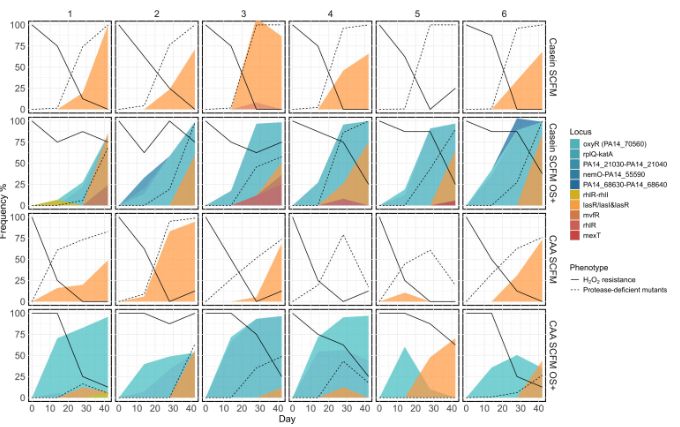
New home office assistant is doing his part to help boost morale
06.10.2025 07:15 — 👍 5 🔁 0 💬 0 📌 0@ellinoralseth.bsky.social
Eco-evo with microbes. I happen to like fjords, I think they give a lovely baroque feel to a continent. The University of Tromsø. Opinions my own. She/her

New home office assistant is doing his part to help boost morale
06.10.2025 07:15 — 👍 5 🔁 0 💬 0 📌 0
New preprint!
Ever wondered why only a fraction of genomes encode CRISPR immunity? 🧬 🦠
Turns out CRISPR is rarely beneficial against virulent phages, being most beneficial against those for which resistance mutations are rare!
An epic effort by Rosanna Wright
www.biorxiv.org/content/10.1...


New family member added! Say hello to Molotov 🔥
05.10.2025 09:44 — 👍 9 🔁 0 💬 0 📌 0Published in Current Biology! P. aeruginosa can use its filamentous phage to inhibit competitors but high phage production is susceptible to cheater miniphage invasion. Subsequent phage tragedy of the commons can lower bacteria and phage fitness. Link: authors.elsevier.com/c/1lt5I3QW8S...
02.10.2025 15:54 — 👍 36 🔁 18 💬 6 📌 2So happy for you! This work is honestly so amazing, congrats 🎉
03.10.2025 10:46 — 👍 1 🔁 0 💬 0 📌 0
DYK most P. aeruginosa carry filamentous phage(s) that don't need to kill the cell to reproduce?
We 👉🏻@nanamikubota.bsky.social show that these Pf phages can go ROGUE.
"Filamentous cheater phages drive bacterial and phage populations to lower fitness"
🔗 authors.elsevier.com/c/1lt5I3QW8S...

A teal flyer for a PhD opportunity to investigate how warming may change antimicrobial resistance. The project will use experiments on Klebsiella bacteria to answer questions about how temperature affects their response to antibiotics, plasmid transfer, and fitness costs. The research involves microbiology lab work, bioinformatics, and mathematical modeling. The flyer includes contact details for Dr. Daniel Padfield and the logos of the sponsoring institutions.
I have an MRC-funded PhD project available (www.exeter.ac.uk/study/fundin...) on how warming will change the problem of AMR. Join a small and friendly group (padpadpadpad.netlify.app/about) in (sometimes) sunny Cornwall. 🧪🦠 #microsky
Please share the ad below with anyone who may be interested.
Come and work with me and @ariannebabina.bsky.social on #Streptomyces evolution and antibiotic production
Origins of a tangled bank: Adaptation and evolution in antibiotic-producing Streptomyces
www.gla.ac.uk/postgraduate...
please repost

The role of mobile genetic elements in adaptation of the microbiota to the dynamic human gut ecosystem
#CurrOpinMicrobiol from @lgbacteria.bsky.social
www.sciencedirect.com/science/arti...

Collab with the Norwegian team at UiT – Tromsø : #phage ISP infects #Staphylococcus borealis species and its efficacy was boosted by adaptation to enable #phagetherapy use.
doi.org/10.1186/s129...
#Microbiology #HostRange #Antimicrobials #PhageAdaptation #NewSpecies #AMR
When you swear to never work on phages, but phages still work on you… :)
Very cool story!!!

View from the lab now. Did I mention that we are recruiting faculty microbiologists?
www.linkedin.com/posts/vaughn...
Now peer-reviewed, improved and published in @microbiologysociety.org Microbiology - thanks to editor and reviewers!
www.microbiologyresearch.org/content/jour...

Delighted to see our paper studying the evolution of plasmids over the last 100 years, now out! Years of work by Adrian Cazares, also Nick Thomson @sangerinstitute.bsky.social - this version much improved over the preprint. Final version should be open access, apols.
Thread 1/n
Recent paper from the lab studying predictors of phage cocktail efficacy against complex clinical Pseudomonas populations
royalsocietypublishing.org/doi/epdf/10....
Led by Rosanna Wright with extraordinary MSc (PhD) student Maisie Czernuska

Excited to annouce the latest research published by our lab, which is led by Dinesh Subedi and is out today in Nature Microbiology.
www.nature.com/articles/s41...

🚨 Microbiologists! We are recruiting Assistant / Associate Professors in 3 collaborative areas of our U. Pittsburgh School of Medicine.
1) MMG (my dept): fundamental research in med micro
2) Peds ID / I4Kids institute
3) Center for Vaccine Research
🔗 to all 3 w/info: www.linkedin.com/posts/vaughn...

How much of selection in human microbiomes is driven by phage?
Excited to share our latest, led by A. Delphine Tripp, showing a case where phage is just not that important:
Phage-mediated lysis does not determine Cutibacterium acnes colonization on human skin
www.biorxiv.org/content/10.1...
🧵

Yet again, machine learning — even gussied up via the transformer architecture — encodes and reinforces societal biases.
This study reveals that LLM-based peer review relies heavily on author institution in its decisions.
arxiv.org/abs/2509.15122

🐟💊🦠Our new study in @natwater.nature.com 🐟💊🦠
"Microbial risks triggered by oral administration of antibiotics in fish aquaculture persist long after the legally mandated antibiotic withdrawal time"
www.nature.com/articles/s44...
#microsky #amr
1/8

Exclusion systems preserve host cell homeostasis and fitness, ensuring successful dissemination of conjugative plasmids and associated resistance genes url: academic.oup.com/nar/article/...
19.09.2025 09:30 — 👍 3 🔁 1 💬 0 📌 0
www.biorxiv.org/content/10.1...
#phagesky #phage
Anecdotally, a few years ago a very trigger-happy temperate had infected a strain of E. coli of mine and caused significant lysis. The release of enzymes in the medium degraded a sugar into a different form which could be used by the other cells.
This promises to be a great read!
“the pathogenicity island was horizontally transferred from Yersinia pestis to E. coli and other Enterobacterales approximatively 4,800 years ago” ⏩️ it then spread to Klebsiella and positively selected over the last 100 yrs ago

Super paper from the mighty Mia Winkler, @genomarit.bsky.social and Iren Lohr.
"We have previously shown that there were relatively few strain-sharing events across ecological niches...plasmid-sharing is considerably more common across niches than strain-sharing. "
www.biorxiv.org/content/10.1...
If there were a collection of E. coli with every combination of a bunch of resistance markers fluorophores on the chromosome, would this be something people would be interested in using?
17.09.2025 01:57 — 👍 27 🔁 6 💬 3 📌 1Congrats!
16.09.2025 10:44 — 👍 1 🔁 0 💬 1 📌 0
Population densities and frequencies of protease-deficient mutants over time. Differences in environmental factors associated with inflammation varied the population density (A) and the frequency of evolved protease-deficient mutants, PDMs (B), over time. Box plot tracks the average and overall distribution of population density at each detected time point within each selective environment. Each line shows the tracked population density or PDM frequency along the daily passage in a single population, grouped by selective environments (Casein SCFM or casamino acids, labeled CAA SCFM, and with or without supplemented 2 mM hydrogen peroxide, OS±).
Using experimental evolution in host-mimicking media, researchers show that inflammation-like environments limit the loss of quorum sensing—a common adaptation during chronic infections—in Pseudomonas aeruginosa. Learn more in #mSystems: asm.social/2vd
16.07.2025 16:37 — 👍 23 🔁 14 💬 1 📌 0How do loci for bacterial capsules (Klebsiella) manage to get swapped around despite their outstanding phenotypes? They just plug and play, having little impact on the rest of the genome. Kudos to @julielebris.bsky.social , check her thread below
11.09.2025 06:18 — 👍 24 🔁 10 💬 0 📌 0
www.nature.com/articles/s41...
#phagesky #phage

A screenshot of Google Maps of Oxbridge, Dorset
My plans to start a new university in Dorset have run into significant economic headwinds, but I am confident that the business case is solid
10.09.2025 08:32 — 👍 42 🔁 4 💬 0 📌 0